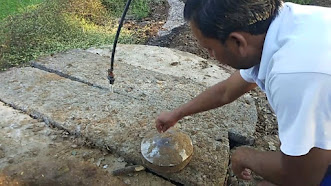1
WEEK INTERNSHIP WORKSHOP ARTICLE REPORT
Basic Dairy Management and Practices
यह आर्टिकल हिन्दी में भी उपलब्ध है | Click here |
Day - 1
1-Feb 2021,
Evening 4 P.M
Location and Area-
Anil Dairy located near the Jabalpur - Rawa Bypass(Highway) 22 km away from Jabalpur City.
The full address of the Dairy is as follows- 6, Gram Raypura, Near Sani Mandir, Ward no. 1, Post Raypura, Panagar, Jabalpur (M.P) - 483220
The area
surrounding the dairy is agricultural fields were mainly Berseem crop are
cultivate because of high demand of Forage crop demanded by this dairy on daily
bases.
And the exhaust old slurry is allowed to flow
in the fields of berseem crops, which acts as increasing Fertility factor.
Berseem
fields are just beside the Biogas plant. And very near to Dairy also. I also came to now that Berseem seed are sown ones and it give
continues productivity up to 6 times after cutting.
Inside the dairy-
The entrance gate of dairy is about 11 feet, so as it only way to entre tractors, cars and other transportation vehicles.
The dairy
area is divided into 4 parts:-
- Open area - open floor and Water tank
- Close area/Shed area - in 3 parts
- Storage Unit
- Young Calves House - combine with Storage area.
Full area of
dairy is covered by concrete floor is slight depression towards outlet
channels though which water and Cow urine is washed out.
Fans are
provided to Cattles (during summer). And plastic sheets are tied, which are shut
the area during nigh hours.
In Open
area a 110 feet Deep Bore well situated which runs with 1/2 HP motar fulfilling
the complete need of water for whole day.
Day - 2
2 Feb 2021, Evening 5 P.M
Dry forage is served to Cattles and Cleaning of Fym started.
Then after
Container Can are ready with Filter (Channi) in there tips.
1 Person
collects the Fym from Dairy and transports it to agriculture land where it will
ferment and some portions of it will use for biogas.
Another
person is preparing Feed of cattles for the next day. Ingredients and
procedures of preparation will we tough in next day of the workshop.
Other 2
person start to milch the Cattles.
Then
milching starts one by one. So, there are 40 cattles in there, out of
which 26 are lactating.
[NOTE- Since use of Oxytocin in completely banned
by Govt. so here no Oxytocin is used.]
One by one
calves of respective Buffalo is allowed to feed.
After 2 mins mother will start to lactate. The bucket full of milk is dumped into the Cans.
Average
time consumed for one cattle is approx 12-15 mins.
So, 12-15
X 26 = 312-390 mins
Converting it in Hours => 312-390 / 60
= 5.2 - 6.5
Since 2
people are working => 5.2 - 6.5 / 2
= 2.6 -
3.2 Hours.
Day - 3
3 Feb
Wednesday, Evening 5 P. M
Today i will learn about Types of feeds with their Ingredients.
- Makka residue powder (3 kg /cattle
- Mustard residue(sarso ki khali)
- Fermented wheat residue( for fat content)
- Moong dal residue ( for protein)
- Berseem
- Ca. syrup ( 100gm/cattle)
- Salt 20-25 gm/cattle
- Mustard oil 200g/cattle
For 10 kg
forage -> 10 lit water is mixed
Breed
of Cattle -> MURRA BREED (Identified by Round Horns)
Day –
4
4 Feb
Thursday, 6 P.M
Total Average milk produced by cattles is day time is approx. – 140 lit
Total Average milk produced by cattles in
evening is approx – 110 lit
Total
Average milk produced by cattle is whole day is = 250 lit.
Her we came
to now that the reason behind for less production of milk in evening is due to
less time availability for rest to the cattles.
In
24 hours -> 12-14 lit milk/cattle
Average Food requirement for 1 cattle
10 kg concentrate + 20 kg Dry forage + 5 kg
green forage
= 35 kg
For 40
cattle = 35 kg X 40
= 1400 kg
Water = 95
lit for one X 40
= 3800 lit
Day –
5
5 Feb, Friday, Evening 7 P.M
There after
the mulching is over, batch of 2-3 cattle are allowed to walk to water tank
for drinking water one by one.
And at the
same time, one person cleans the floors and collection of FYM and urine takes
place.
Milk Storage and TRANSPORTATION
Milched milk
is collected in CANS.
Volume of 1
can = 40 lit
Volume of 3
can = 40 X 3 = 120 lit
Freshly collected milk is transported
to NARMADA DAIRY.
Then form Narmada Dairy the is Transported to AMUL.PVT.LTD Branch – JABALPUR. After floor cleaning and fym collecting. Cattles are served with freshly harvested berseem. And are allowed to rest for the NIGHT.
**THE WHOLE PROCEDURE AND EVENTS ARE REPEATED IN THE EARLY
MORNING FROM 4 A.M AND CONTINEWS TILL 8-9 A.M.
Day –
6
6 Feb, Saturday,
Evening 7 P.M
Today I learned about “HOW PRICE OF MILK IS DECIDED”
Rate of milk
is decided according to its Fat Content. There are continuous fluctuations in
value rate in day to day basis. Fat is
measure in gram per lit in milk.
Here, the
rate of milk is about 48 RS/lit for the day time.
And about 52
RS/ lit for the evening time.
Conclusion –
In this 1
week workshop program, I have learned about Basic Dairy Management and
Practices which are highly required skill for maintaing and to run the dairy
smoothly with profit.
I received a
great knowledge about forage and feed of cattle, preparation and storage.
Animal behavior
and there pattern of feeding, nature.
Milk collection, storage and its Transportation.
About BIOGAS PLANT, and berseem crop.
**THANK YOU**
- TAPSENDRA PATEL









Comments
Post a Comment